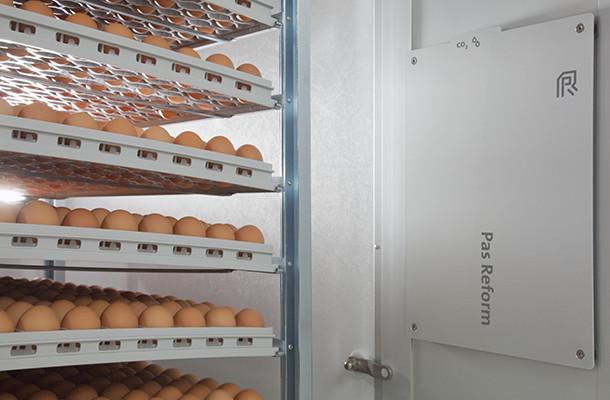Managing carbon dioxide in the setter
Tags: Incubation | Whitepaper
, March 1 2016

Fresh, dry air contains approx. 78% nitrogen (N2), 21% oxygen (O2) and 0.04% carbon dioxide (CO2). Yet while oxygen is a prerequisite for life - and essential for successful incubation - we rarely monitor oxygen levels inside setters and hatchers, or measure O2 as a parameter for adjusting the supply of fresh air by ventilation. On the contrary, CO2 – the by-product of embryo metabolism - is commonly monitored and measured to provide profiles for adjusting ventilation during incubation.
Just after laying, the albumen of an egg contains a considerable amount of CO2, mostly present as bicarbonate. Since egg shell is porous and the concentration of CO2 in the environment is much lower, CO2 diffuses out of the egg. This results in an increase in the pH of the albumen as well as its liquefaction, both of which are needed to prepare the egg for incubation.
As this process of passive CO2 diffusion from the egg continues during storage and in the first days of incubation, the concentration of CO2 inside the fully sealed setter will gradually increase. The fresher the egg, the faster the increase and the higher the accumulated level of CO2. Since the embryo’s metabolism and therefore its demand for O2 during the first 10 days of incubation is very low, the gradual increase of CO2 to >1% does not hamper the embryo’s metabolic development. A study by Bruggeman et al. (2006) showed that, due to several buffering mechanisms, broiler embryos can tolerate a gradual increase to 1.5% CO2 at day 4 of incubation, maintained until day 10. A study of white layers by Hongbin Han et al. (2011), however, showed negative results when applying 2% vs. 0.03-0.05% during the first 4 days, which suggests a greater sensitivity to CO2.
The fact that no fresh air enters the setter during the first 10 days of incubation may be beneficial for temperature uniformity, depending on the type of incubator. However, it is not only the concentration of CO2 (in a non-ventilated setter) that increases. This also applies to relative humidity, resulting in a reduced rate of egg weight loss during the first 10 days, which has to be compensated for during the last part of the setter period by imposing an extremely low relative humidity set point. The risk of such unnaturally low relative humidity during the final days in the setter is that water will evaporate from embryonic tissues, which by that time are found directly under the shell surface.
After day 10–12, embryo metabolism increases exponentially and the need for O2 - and thus the production of CO2- increases. It is commonly accepted that in this period, the ventilation rate of the setter should gradually increase. Over-ventilating, which may result in over-active humidifiers in an attempt to keep relative humidity at set point, is unnecessary. The ventilation rate in this period can be fine-tuned safely to a maximum CO2 level of 0.4%.
Advice
- Ensure that air in the clean air plenum of the setter (and hatcher) contain max. 0.09% CO2.
- Check and replace the filters in the Air Handling Unit regularly.
- Avoid or minimize the recirculation of ‘used’ air.
- Ensure CO2-sensors in the setter (and hatcher) are calibrated correctly for the hatchery’s altitude. If calibrated for sea level, use a correction factor or a different set point.
- Remember that sealing the setter during the first days of incubation not only increases CO2-level, but also RH%.
- Start to ventilate the setter gradually, preferably no later than on the third day of incubation. Fine-tune ventilation >day 10–12 on a fixed max. CO2-concentration.